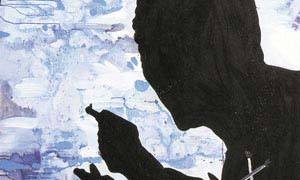The exhibition offers a cross-section of the approaches and possibilities currently to be found in painting, which is anything but regional in its perspectives. Although the concentration on Düsseldorf reflects, as already stated, the rich tradition to be found there, the influence of this “school of painting” can often be seen to go far beyond. Artists such as Helmut Dorner, Katharina Grosse, Thomas Huber, Markus Oehlen, Michael van Ofen, Andreas Schulze, and Dirk Skreber, to name but a few, occupy important places in the international art scene. My aim in this exhibition has been to accompany the most recent generation of painters (born between 1969 and 1978) on their first steps to national acclaim.
The title The New Düsseldorf School of Painting is not without a certain irony, for it is clear that in the age of global communications something like a school of painting in the traditional sense is no longer feasible. The references to the international art context are certainly more salient than those to the academy itself. At the same time, it contains an allusion to the renowned Düsseldorfer Malerschule that emerged from the Academy in the 19th century and reached its zenith in the 1830s. Thus the title is in some ways provocative.
What are the main concerns of painting today? One thing is certain: the technical media of film, television, video, computer, photography, daily newspapers and magazines have all left their mark on the oldest medium. But in some respects that already occurred with the dawn of Pop Art in the 1960s, at the very latest. Has there been a change since then in the way the world of media images is assimilated? I believe so. Because compared to previous years, it is only briefly touched on as a phenomenon in its own right. Today, young painters use the battery of images purely as a matter of course. Often the technical image is assigned no more than the status of a sketch. And when it is actually incorporated into a painted picture, it can be seen to undergo every conceivable variation in its transformation, from citation to visualized recollection, to total assimilation. In fact, in many cases it is an open question whether the motifs were sourced from the media or came from direct observation. After all, the television hardly attracts more attention in everyday terms than the other objects at home. It accompanies as it were daily life in the background, and this constant accompaniment has made us citizens of the global village, as McLuhan diagnosed. It is a long time now since people asked about the origins of what is communicated, because syndicated news is granted no more credence than neighbourhood gossip.
The mental horizons of the present-day artist are not left untouched by this, particularly when he or she commits things to the world of visual experience that have a relationship to our life world. At the same time the history of art, which has always been a concern of the youngest generation of artists, even before the media age, is anything but forgotten. It is accompanied however by the boundlessness of the images that are plied on all sides. As such, the inherent potential of art has been decisively reduced. If it wishes to command attention, it has little choice but to return to those means that it and it alone possesses. Here the coloured surface announces itself, because that is where painting finds its own personal territory. Innovation in painting always occurs in that electric field between paint and ground. It is all the same what sources the young artists use: decisive for the effect of a painting is the process in which the paint assumes form, regardless whether representational or abstract. Although figurative painting dominates among the selected artists, they touch on every degree of abstraction. This was also important for the selection that was made. The exhibition spreads out a whole range of possibilities in the field of painting; each of the artists has a specific manner of painting they can call their own, however visible their references to other paintings and media.
Having initiated a collaboration between the Krefelder Kunstmuseum and the Herzliya Museum of Contemporary Art for the purpose of staging the exhibition The New Düsseldorf Painting School, my colleague, Dalia Levin, suggested expanding the show’s scope to include young Israeli painters as well. Since all the German participants are graduates of the Düsseldorf Staatliche Kunstakademie, we decided to select Israeli artists who graduated from the Bezalel Academy of Art and Design, Jerusalem. During December 2003 I made a series of studio visits, and finally selected seven artists whose works represent a wide range of artistic reference points.
The joint exhibition entitled This Time Painting! is a challenge, for not only does it offer an inter-national comparison between artists of the youngest generation, but it also focuses on a medium considered anachronistic in our time. The first conclusion emerging from the show may be somewhat surprising: even though the artistic tradition of the Staatliche Kunstakademie in Düsseldorf is intensive, vital and much older than its Jerusalem counterpart, one can say decisively that both groups present an equal artistic quality, probably due to the fact that in both instances the references to the international artistic context exceed the allusions to local traditions.
Less surprising but equally interesting is the fact that the Israeli artists display a greater passion for experimentation than their German counterparts; they may be said to explore painting from its margins. An artistic tradition is an inexhaustible treasure, but it might also be a burden that one chooses to bear, or alternatively – disregard.
Curator: Dr. Martin Hentschel, Krefelder Kunstmuseen, Germany
The exhibition was generously supported by the Federal Foreign Office, Germany and Kunststiftung NRW, Düsseldorf
Less Reading...
